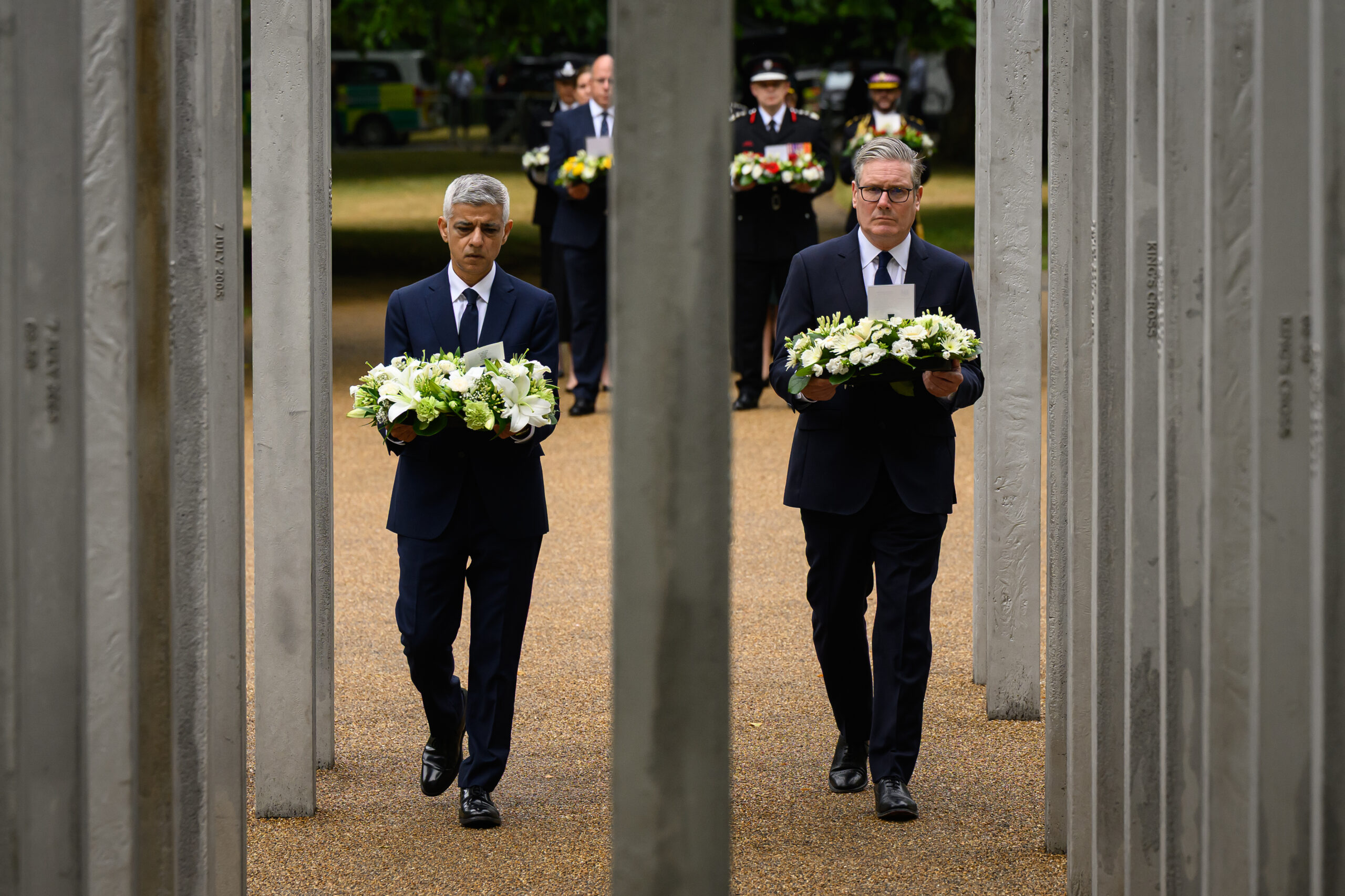
Stay
UpdateD
Join the BPC
Email List
Stay up to date on exciting projects and upcoming events from the Black Promoters Collective.

The normalcy of London, marked by people rushing to work and the usual city buzz, was shattered on July 7, 2005. In a series of devastating, coordinated suicide bombings across the capital’s public transport system, there was a staggering death toll. The attacks, which are now referred to as the 7/7 London bombings, occurred at 8:50 a.m. and killed 52 people, with hundreds more injured. Two decades later, Netflix has released Attack on London: Hunting the 7/7 Bombers, a sobering and powerful documentary series that revisits the day through survivor stories, investigator insights and newly released footage.
This new doc is a welcome addition to Netflix’s robust true crime lineup, which investigates some solved and unsolved tragedies. But what exactly happened on that day? Who were the victims and perpetrators of the 7/7 bombings in London? And how does this new documentary fit into the wider narrative of terrorism in the UK? Here’s what viewers need to know as they explore the tragic piece of world history.
As Westminster City Council reports, the 2005 London bombing was an incredibly heartbreaking occurrence. At the time, “four suicide bombers detonated devices in Tavistock Square, near Aldgate, Edgware Road and Russell Square stations.” The morning attack was meant to devastate Londoners at the peak of rush hour. At 8:50 a.m., three bombs exploded nearly simultaneously on separate Underground trains. To this day, there are commemorations for those who passed each year.
People reports how one device detonated on a train between Liverpool Street and Aldgate, while another went off between Edgware Road and Paddington. The third went off in a tunnel between King’s Cross and Russell Square. Then, just under an hour later, at 9:47 a.m., a fourth bomb was detonated on a double-decker bus in Tavistock Square. The bombers selected these locations to create maximum disruption and confusion across the city of London.
The immediate aftermath of the 7/7 bombings in London was chaos. Emergency services responded swiftly, but the overall damage was overwhelming. Trains were mangled beyond repair, tunnels filled with smoke and countless panicked passengers struggled to escape. Even cell phone networks collapsed under the strain as people frantically tried to contact their loved ones during the emergency. And as the city ground to a halt, Londoners walked miles to get themselves home. Yet the true scope of the horror caused by this attack was revealed when the number of innocent people who had died or were injured was assessed. These attacks are commonly referred to as the worst on British soil since World War II.
The 52 7/7 victims came from diverse backgrounds, with different ages, nationalities, ethnicities and professions. This reality reflects the multicultural makeup of London itself. The victims of this tragic day were everyday people commuting to work, attending meetings or simply traveling across the city. At Russell Square, there were the highest number of casualties; this is where many young professionals passed. The Aldgate and Edgware train locations were areas filled with students, working people and families. And the bus bombing was equally devastating, with people coming home from their night shifts as cleaners and social workers joining the list of victims.
Many of the families of those who passed on 7/7 have started foundations and memorial projects to honor their loved ones. Their individual stories serve as a powerful reminder that the lives lost in this mass tragedy were more than just statistics. They were individuals with families, dreams and futures that were tragically cut short. Each of their names were acknowledged in the recent 20th anniversary memorial service at St Paul’s Cathedral, which can be viewed on the BBC website.
The four men responsible for the 7/7 bombings were all British citizens. They were radicalized within the UK and united by extremist ideology. Their names are Mohammad Sidique Khan, Shehzad Tanweer, Hasib Hussain and Germaine Lindsay. All four of them were from a Muslim background, with three of them being of Pakistani descent and one Jamaican-born convert to Islam. While they had no formal ties to a large terrorist organization, they reportedly traveled abroad before the attacks. They were all seemingly living ordinary lives, but turned out to be extremists.
As BBC reports, the group had a ringleader in Mohammad Sidique Khan, aged 30. He worked as a teaching assistant in West Yorkshire and was generally described as a quiet, well-respected figure in the community. Then he carried out the attack at Edgware Road on a Circle Line Train. Shehzad Tanweer, who was 22 at the time, had a degree in sports science and was responsible for the Aldgate bombing. This explosion killed eight people and injured over 100 more.
Germaine Lindsay, aged 19, detonated his bomb between King’s Cross and Russell Square. This attack had the highest death toll at a single location, with 27 victims. Hasib Hussain was just 18 years old and the youngest of the bombers. He was responsible for the Tavistock Square bus bombing. This bus bombing occurred because his initial train failed to detonate. So, he then boarded a number 30 bus instead.
What made these attacks so chilling is the fact that none of the bombers’ families knew about what they were doing or planning, as The Standard recalls. All four bombers were raised in the UK and had seemingly normal lives. Yet, under the surface, they had become radicalized, which stunned the nation. This horrific act is what led to a significant overhaul in British counterterrorism strategies.
Another attack that caused major shifts in the UK was the 2017 London train bombing. This transport-related attack occurred on a much smaller scale compared to 7/7, as BBC reports. On Sept. 15, 2017, a crude homemade bomb was placed on a District Line Train and detonated during the morning rush hour. This occurred at Parsons Green station in southwest London. The only reason the incident was not a bigger attack is that his device only partially exploded. It was concealed in a white plastic bucket inside a shopping bag, and the partial explosion caused a fireball. This injured 30 people, but the bomb malfunctioned, which likely prevented mass casualties.
The perpetrator of this attack, Ahmed Hassan, was an 18-year-old Iraqi asylum seeker who had been living in the UK. He had told immigration officials that he was coerced into ISIS training in Iraq. But later, he denied association with the group. During the investigation, his deep resentment toward the UK was revealed. It was also discovered that he had plotted the attack for months. He was eventually convicted of attempted murder and sentenced to life in prison.
While the Parsons Green attack did not take any lives, it did reignite public anxiety and highlighted the risks that extremists pose. Though smaller in scale, this attack served as a reminder that terrorism continues to evolve and that public vigilance and safety remain critical.
Netflix’s Attack on London: Hunting the 7/7 Bombers offers a gripping look at one of the darkest days in British history. Across four episodes, the series blends emotional survivor testimonies, dramatic real-time footage and expert insights to piece together the truth. The result of this combo is a documentary that feels both deeply intimate and powerfully investigative. What sets this series apart is its human focus. Rather than centering only on the perpetrators or political rhetoric surrounding the attack, Attack on London gives space to those impacted.
Survivors like Dan Biddle, who lost both his legs in the Edgware Road bombing, are given the spotlight to tell their story. The surviving victims of the bombings offer harrowing accounts about their experience. These firsthand accounts beg viewers to truly face the horror of what they went through.
And this doc does not shy away from the more investigative sides of things concerning the 7/7 bombings in London. It also delves into things like the CCTV footage and forensic evidence, which helped to identify the attackers within days of the attacks. The documentary touches on controversial aspects of the aftermath while also keeping a respectful storytelling perspective. It avoids sensationalism in favor of clarity and depth, but it is definitely not an easy watch.
By the end of the series, viewers are left with a clear understanding of what happened on 7/7. They are also given a deeper appreciation for the resilience of the city, heartbreak of the victim’s families and the challenges of confronting domestic extremism.
What nationality were the 7/7 bombers?
All four of the 7/7 bombers were British born and from the Beeston and Holbeck areas of Leeds, per BBC.
Which part of London was bombed the most in WWII?
During WWII, the Eastern end of Central London was targeted most due to its important docks and industrial areas, as BBC reports.
Stay up to date on exciting projects and upcoming events from the Black Promoters Collective.

©2025 Black Promoters Collective (BPC) All Rights Reserved.